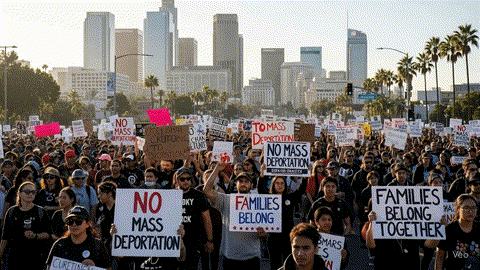Protests Grow Across America as Trump’s Mass Deportation Machine Faces Rising Resistance
By David LaGuerre –
Protests of President Trump’s immigration policies grew across the U.S. on Tuesday, with rallies held in New York City, Chicago and Seattle. The question isn’t whether Americans would push back against what many see as an unprecedented assault on immigrant communities – it’s how far this grassroots resistance will spread and whether it can meaningfully challenge the administration’s deportation apparatus.
What we’re witnessing isn’t just scattered demonstrations, but the emergence of a sustained movement that spans from coast to coast. In cities where immigrant families have built lives for decades, people are taking to the streets with a simple message: not in our communities, not on our watch.
The Scale of Resistance Takes Shape
The numbers tell a story of growing unrest that the administration can no longer ignore. Large-scale protests have occurred in Alabama, California, Georgia, Illinois, Indiana, South Carolina, and Texas. From the bustling streets of Los Angeles to the heart of St. Louis, where approximately 1,000 participants gathered to protest the Trump administration’s enhanced deportation efforts in the metro area, with many playing drums, chanting, and conducting organized calls through bullhorns.
What makes these protests different from typical political demonstrations is their deeply personal nature. These aren’t abstract policy debates – they’re neighbors defending neighbors, communities protecting their own. In California’s immigrant communities, families are literally putting their bodies between ICE agents and their loved ones.
The Trump administration has responded with unprecedented force. On June 7, Trump ordered National Guard troops to Los Angeles to quell anti-ICE protests. The escalation didn’t stop there. Trump sends 700 Marines to LA, doubles number of National Guard as the administration clearly views these protests as a serious threat to their immigration agenda.
The Reality Behind the Resistance
To understand why these protests have gained such momentum, we need to look at what’s actually happening on the ground. The Trump administration has claimed that around 140,000 people had been deported as of April 2025, though some estimates put the number at roughly half that amount. Regardless of the exact figures, the impact on communities has been devastating and visible.
The administration’s approach has been anything but subtle. The Department of Justice is weighing arresting and prosecuting public officials who impede their immigration agenda, according to Administration sources familiar with the matter. This threat against local officials who try to protect their constituents has only intensified the backlash.
What’s particularly striking is how public opinion has shifted. By April 2025, slightly over half of Americans felt the level of deportations went “too far”. This isn’t just opposition from traditional Democratic strongholds – it reflects a broader discomfort with the human cost of mass deportation operations.
When Federal Force Meets Local Resistance
The scenes playing out in Los Angeles represent something we haven’t seen in recent American history: federal military forces deployed against American citizens protesting immigration policy. California sued the Trump administration to block deployment of the National Guard and the Marines, arguing that it violates federal law and state sovereignty.
This legal challenge goes to the heart of our federal system. When a state government directly challenges federal military deployment on its own soil, we’re in uncharted constitutional territory. Governor Gavin Newsom’s decision to take this fight to court isn’t just political posturing – it’s a fundamental question about the limits of presidential power and the rights of states to protect their residents.
The protests themselves have evolved beyond traditional demonstrations. The “Day Without Immigrants” actions saw businesses across multiple cities shut down in solidarity, demonstrating the economic integration of immigrant communities. When restaurants, construction sites, and service businesses close their doors, it becomes impossible to ignore how deeply woven these communities are into America’s economic fabric.
The Moral Center Holds
What gives these protests their staying power isn’t just anger – it’s a clear moral foundation that resonates with American values. The sight of families being separated, of children afraid to go to school, of neighbors disappearing in the night runs counter to our deepest beliefs about fairness and human dignity.
Critics of the resistance movement argue that immigration law must be enforced, that the protests are enabling lawbreaking. However, the scale and intensity of the response suggests something deeper is at stake. When thousands of Americans are willing to face arrest to protect their immigrant neighbors, they’re making a statement about what kind of country we want to be.
The administration’s heavy-handed response has only strengthened this moral clarity. The deployment of Marines against American protesters crosses lines that make many uncomfortable, regardless of their views on immigration policy. It’s one thing to support border security; it’s another to support military force against citizens exercising their constitutional rights.
Looking Forward
These protests represent more than opposition to a particular policy – they’re a test of American democracy itself. The question isn’t whether the Trump administration will continue its deportation efforts, but whether the growing resistance will force a recalibration of how those efforts are carried out.
The legal challenges are mounting, the public opinion is shifting, and the moral opposition is deepening. History suggests that when Americans decide a government policy goes too far, sustained resistance eventually forces change. The civil rights movement, the anti-war protests of Vietnam, the battle for marriage equality – all show how grassroots opposition can reshape the political landscape.
What we’re seeing in cities across America isn’t just protest – it’s democracy in action. People are using their voices, their votes, and their bodies to defend values they believe are fundamental to who we are as a nation. Whether this movement can ultimately reshape immigration policy remains to be seen, but it has already reshaped the debate.
The growing protests against mass deportation reflect something essential about American character: when pushed too far, we push back. The question now is whether our democratic institutions can channel this energy into meaningful change, or whether we’ll continue to see federal force deployed against American citizens standing up for their neighbors.
What do you think? Are these protests necessary resistance to government overreach, or do they undermine legitimate law enforcement? Share your thoughts in the comments below, and don’t forget to share this story with friends who care about these issues.




